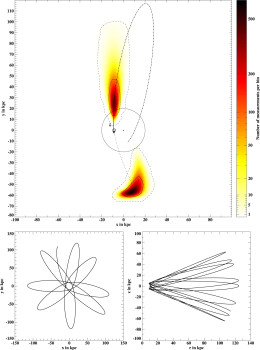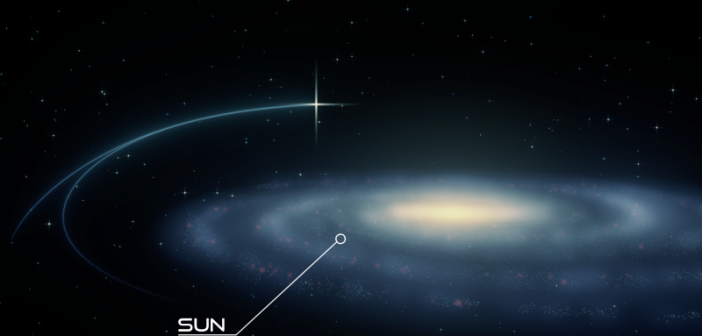The recent discovery of a hyper-velocity binary star system in the halo of the Milky Way poses a mystery: how was this system accelerated to its high speed?
Accelerating Stars
Unlike the uniform motion in the Galactic disk, stars in the Milky Way’s halo exhibit a huge diversity of orbits that are usually tilted relative to the disk and have a variety of speeds. One type of halo star, so-called hyper-velocity stars, travel with speeds that can approach the escape velocity of the Galaxy.
How do these hyper-velocity stars come about? Assuming they form in the Galactic disk, there are multiple proposed scenarios through which they could be accelerated and injected into the halo, such as:
- Ejection after a close encounter with the supermassive black hole at the Galactic center
- Ejection due to a nearby supernova explosion
- Ejection as the result of a dynamical interaction in a dense stellar population.
Further observations of hyper-velocity stars are necessary to identify the mechanism responsible for their acceleration.
J1211’s Surprise

Models of J1211’s orbit show it did not originate from the Galactic center (black dot). The solar symbol shows the position of the Sun and the star shows the current position of J1211. The bottom two panels show two depictions (x-y plane and r-z plane) of estimated orbits of J1211 over the past 10 Gyr. [Németh et al. 2016]
Németh and collaborators found that J1211, located roughly 18,000 light-years away, is moving at a rapid ~570 km/s relative to the galactic rest frame. The binary system consists of a hot (30,600 K) subdwarf and a cool (4,800 K) companion star in a wide orbit, likely separated by several AU.
An Unknown Past and Future
Why are these new observations of J1211 such a big deal? Because all the acceleration scenarios for a star originating in the Galactic disk fail in the case of J1211. The authors find by modeling J1211’s motion that the system can’t have originated in the Galactic center, so interactions with the supermassive black hole are out. And supernova explosions or dynamical interactions would tear the wide binary apart in the process of accelerating it. Németh and collaborators suggest instead that J1211 was either born in the halo population or accreted later from the debris of a destroyed satellite galaxy.
J1211’s speed is so extreme that its orbit could be either bound or unbound. Interestingly, when the authors model the binary’s orbit, they find that the assumed mass of the Milky Way’s dark-matter halo determines whether J1211’s orbit is bound. This means that future observations of J1211 may provide a new way to probe the Galactic potential and determine the mass of the dark matter halo, in addition to revealing unexpected origins of high-velocity halo stars.
Citation
Péter Németh et al 2016 ApJ 821 L13. doi:10.3847/2041-8205/821/1/L13

1 Comment
Pingback: hypervelocity binary star: interesting puzzle